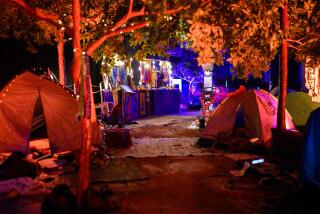Museum to Reflect Jewsâ Suffering, Joy
NEW YORK â The blue sports blouse, bearing a large, blue-on-white Star of David insignia, exerted a powerful hold on Mary Offentierâs youthful heart.
Twice a week, in the mid- to late 1930s, she wore it for after-school gymnastics at the Bar Kochba sports club in Berlin. âThatâs where we met; these were our friends,â she said. So the blouse stirred memories of friendship and good times.
Later, the suffering of its owner, now Mary Offentier Levinsky, wove far deeper layers of meaning into that frail garment. Though it remains a memento of innocent joy, it has also become a powerful artifact of legislated hate, a poignant relic of the comprehensive anti-Semitism that the Third Reich imposed on a thriving, productive minority.
Starting Monday, the blouse will help chronicle modern Judaism at a new Manhattan landmark, called A Living Memorial to the Holocaust--Museum of Jewish Heritage. The events that made the blouse a museum piece began when Adolf Hitler became chancellor of Germany in 1933, and his Nazi Party began enacting restrictions on Jews.
Some Nazi measures, including a boycott of Jewish businesses, affected economic life, gradually squeezing Jews out of flourishing enterprises, such as Heinrich Offentierâs clothing company. âIn 1933, already my father had to give up the business, and we had to move to a small apartment,â said Levinsky, of New York City. âFrom then on, everything went down. Before 1933, we had a maid and there were vacations and we had everything.â
Other restrictions affected cultural life, forbidding Jews even to belong to sports clubs and cultural groups. So the Jews started their own, including the one that Mary Offentier joined in 1936, at age 8, when she began wearing the blue blouse. Her club was not just Jewish, but proudly Zionist, named for Simon Bar Kochba, hero of an unsuccessful Jewish revolt against Rome in the 2nd century.
On Nov. 9-10, 1938, the Nazis unleashed a series of riots in Austria and Germany, destroying synagogues and smashing windows of Jewish shops. This turning-point pogrom became known as Kristallnacht (âNight of the Broken Glassâ).
Soon after, the Offentiers sent Mary and her sister, Hanna, to the safety of Holland. In her small suitcase, she had tucked away reminders of better times. âMy most precious possession was the blouse,â she said.
Levinskyâs blouse is now one of 800 artifacts, along with more than 2,000 photographs and 24 original films in the museumâs core exhibit, designed to educate the public about 20th century Jewish history and the Holocaust.
The museum is on one of the best pieces of real estate in Manhattan: at Battery Park City, opposite Ellis Island and the Statue of Liberty, and near the place where the first Jewish refugees to reach America landed in 1654. Architect Kevin Rocheâs stunning, six-sided structure, with a six-tiered roof, commemorating the 6 million Jews who died in the Holocaust, seems certain to become a gem of the downtown shoreline. It contains 30,000 square feet on three floors--at a cost of $21.5 million for the building and exhibits.
In this imposing new building, the blue blouse and a photo of the Bar Kochba sports club will not be the only traces of Mary Levinsky. Her videotaped image also will appear as part of a documentary on the first floor, where visitors will see and hear her talking about prewar Jewish life in Berlin.
The entire first floor will not focus on the catastrophic events of 1939-1945, but on the richness of the European Jewish culture the Nazis set out to eradicate.
That emphasis on Jewish life, as well as Nazi death-dealing, is the museumâs driving force. âIt doesnât mean that we in any way minimize or understate or compartmentalize the story of the catastrophe,â said David Altshuler, the director. âBut it does mean that you contextualize that story within a larger story about survival, hope, continuity, culture, civilization, so that itâs inhumanity in the context of humanity.â
Even on the second floor, where the museum documents the âFinal Solution,â the context of life is provided. The gallery that covers the death camps has two sides. One offers black-and-white images of mass murder. The other displays photographs of death camp victims, as they looked in family settings, before the Nazis erased their dignity, then their lives.
The third floor focuses on five decades of Jewish life since the Holocaust.
The museumâs location, only a short walk from the terminal for boats to the Statue of Liberty and Ellis Island, provides a strong marketing advantage and a powerful symbolism.
âIt will almost force the visitor to think of those who didnât make it,â said Elie Wiesel, Holocaust survivor, author and Nobel Peace Prize laureate, who has provided key leadership to both the New York museum and the U.S. Holocaust Memorial Museum in Washington, D.C. âThey were not just statistics. They were human beings.â
Altshuler hopes that millions will find inspiration in the museumâs powerful exhibits of terrifying hatred, offset by the evidence of the culture that the hatred couldnât kill. His goal: âI want people to say, âYou know, you will be challenged by this place, but it will renew your faith in humanity. You will come out of this place grounded in an optimism that is not naive, that is not Pollyannaish, but thatâs real.â â
More to Read
Sign up for Essential California
The most important California stories and recommendations in your inbox every morning.
You may occasionally receive promotional content from the Los Angeles Times.










